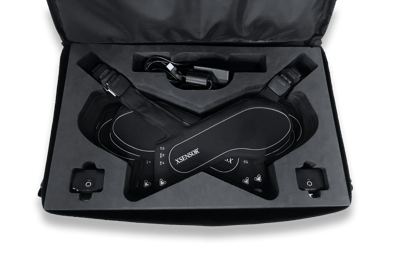
Why I Chose XSENSOR Technology for In-Shoe Pressure Analysis
Through a series of five articles (How Two Decades of Out-Of-Shoe Pressure Analysis Led Me to XSENSOR Technology), industry-leading podiatrist Tim Bransdon will explore and provide insights into what led him to XSENSOR Technology’s Intelligent Insoles, and how the in-shoe analysis is influencing his assessment and treatment strategies for patients, and what XSENSOR means to his podiatry clinic (Wollongong Podiatry) and running programs (The Running Lab). Follow along to learn and understand more about Tim’s experience and process implementing and using the Intelligent Insoles on The XSENSOR Blog.
Read Part 1 and Part 3 to catch up on Tim's adventure.
How Two Decades of Out-Of-Shoe Pressure Analysis Led Me to XSENSOR Technology (Part 2): Why I Chose XSENSOR Technology for In-Shoe Pressure Analysis
I graduated as a podiatrist in 2001. Back then, when you didn’t carry a mainframe supercomputer in your pocket, in-shoe pressure analysis involved wearing a Ghostbusters-sized backpack to record data. Over the following two decades, this seemed to progress only as far as having wires run from your shoe to a fanny pack where the brains of the in-shoe sensors resided. Needless to say the setup was still clunky, and attaining a ‘natural’ walking or running gait was near impossible.
I discovered XSENSOR Technology around the same time I was introduced to in-shoe pressure insoles developed by another company. Both products were a big advancement on previous clunky setups, with the recording device sitting on the shoe, and no other wires required for data collection.
I purchased a pair of insoles from the company whose product I had seen, and booked a meeting with XSENSOR to learn more about their product. My experience, and the products themselves, were very different.
First, the non-XSENSOR insoles…
The pressure sensing insole was in the shape of an insole of a regular running shoe. This seemed logical, and fitting the device to my shoe was a breeze. Unfortunately, this was the only easy part of the process. I had several failed attempts while testing the insoles, with a clunky app that failed on each of my first three attempts to use the sensors. When I did manage to get the system to work, I was presented with several metrics that offered minimal insight into my foot function and my interaction with the ground.
The insoles, despite fitting into my shoe well enough, began slipping forward, resulting in toe discomfort. This had me questioning the accuracy of the data given the sensors shifted throughout the run. My final gripe with these insoles was the necessity to carry my phone with me when using them. I dislike carrying my phone at the best of times, but I do not like running with it.
My end synopsis of this product was that it targeted a different customer. It was designed for the consumer rather than the practitioner. It was also a company building pressure sensing devices for the first time. There were significant flaws with both the hardware and the software.
Second, the XSENSOR Intelligent Insoles…
My first impression of the shape of XSENSOR’s Intelligent Insoles themselves was one of confusion. How could the unique shape of these insoles fit inside a shoe, let alone be comfortable enough to walk or run naturally? What followed when I tested the insoles was sheer amazement. I was able to walk and run without any awareness of the insoles in my shoes. And they didn’t shift at all, thanks to their well-engineered and unique shape. The recording device (sensor pack) which attaches to the shoe caused no irritation as I walked or ran.
Okay, back to my first discussion with XSENSOR. What impressed me the most was the pedigree of the company itself. XSENSOR has a long history in high-end Intelligent Dynamic Sensing for automotive applications like vehicle safety, impact testing, tyre design, and performance testing, as well as mattress and wheelchair seating design. This was not a start-up company trying to provide in-shoe pressure analysis. This was a company with products far more advanced than I had ever used in my podiatry career and now they were bringing this technology to plantar pressure measurement applications.
I could not have dreamed of a better scenario. Instead of working with clunky hardware and a sub-par software platform, I found a product and company where I could hit the ground running.
I was excited to have an opportunity to test what my patient’s feet were doing inside their shoes. I was curious to see what would change with fatigue, with treatment intervention, with strengthening of feet, and with orthotics or other in-shoe interventions.
I was sold. Now I had to control my enthusiasm for a short time until my XSENSOR Intelligent Insoles arrived.
Read Part 3 in the series, “Why I Chose XSENSOR Technology for In-Shoe Pressure Analysis”.
About the Author, Tim Bransdon:
Tim Bransdon is a podiatrist based in Wollongong, Australia. He is an industry leader in the field of strength and conditioning for feet, as well as running mechanics and has two decades of experience using force plate pressure analysis for walking gait, testing strength, and power output. Tim is excited to share his experience in adding a new frontier to his podiatry practice and running work with XSENSOR Technology’s Intelligent Insoles.


